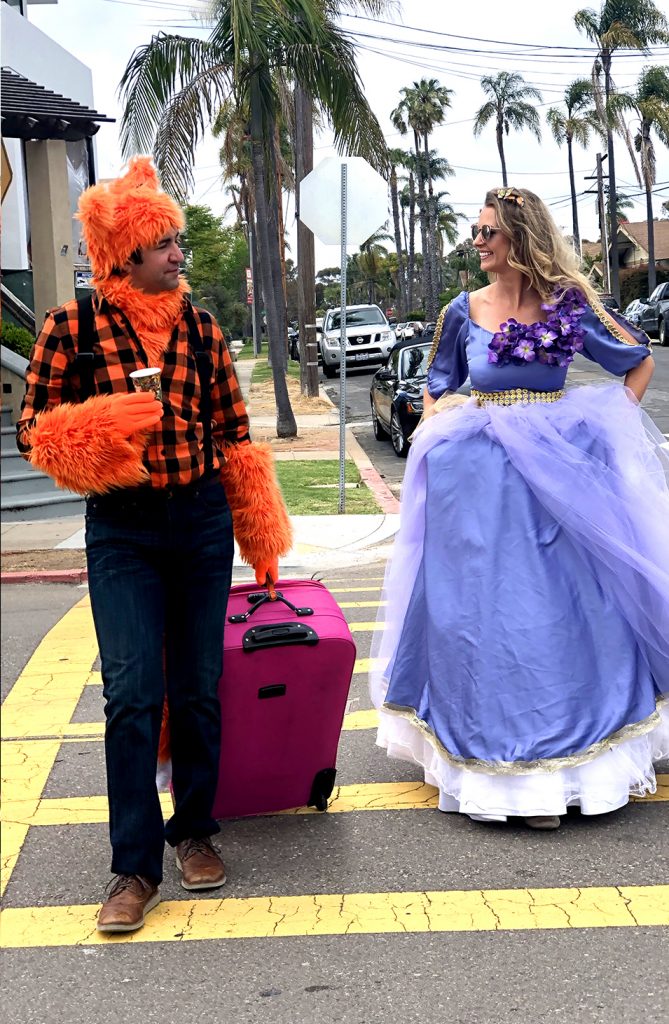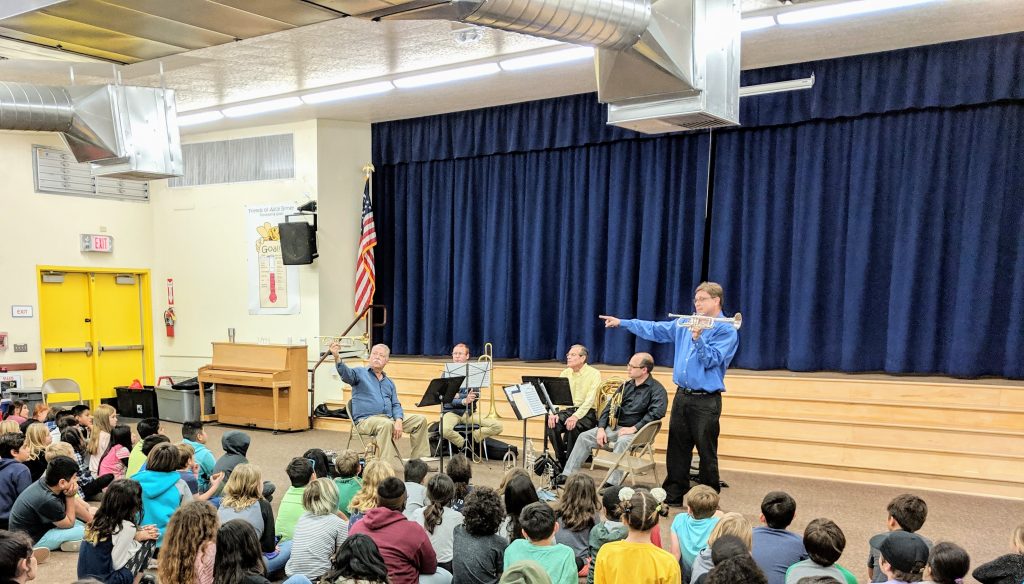Nurturing New Audiences for Classical Music and Opera
Cultivating new audiences for classical music is a Holy Grail pursuit for local performing arts organizations as well as for astute individual musicians in the community. Recent experiences around San Diego have opened my eyes to some worthy outreach work that merits attention, although I realize I have only scratched the surface of creative approaches afoot in San Diego County.

Bernardo Bermudez & Victoria Robertson in costume on the way to an Opera4Kids gig [photo (c.) Nina Deering]
Early in The Enchanted Tail, for example, Bermudez sings the familiar “Toreador” Song from Bizet’s Carmen, but with words that introduce him to the audience as the rugged woodsman. Robertson as the story’s princess and Bermudez’s woodsman get to know each other in an encounter that relies on the Violetta-Alfredo duet—with new words—from the first act of Verdi’s La traviata. Pianist Nina Deering not only accompanies the singers but supplies additional dramatic music between the various arias and duets that binds the opera together and keeps the mood of the story fresh. As Robertson’s tale unfolds, we hear more music from Rossini’s The Barber of Seville, Offenbach’s Tales of Hoffmann and Mozart’s The Magic Flute.
To engage the youngsters, Robertson regularly breaks the dramatic fourth wall and asks the children questions. When the fox, Bermudez’ other character, steals the princess’s crown, Robertson plaintively asks the children in the audience where she can find her stolen crown. Without the slightest prompting, in unison the youngsters stand and eagerly point to the fox hiding on the other side of the stage and shout to her, “Look, it’s over there—he has it!”
Although the antics and the dialogue of the characters in The Enchanted Tail are tailored to the expectations of grade school students, the production’s musical level meets any adult opera attendee’s highest standards. In recent seasons I have reviewed Bermudez in leading roles with San Diego’s Opera NEO company, and last month–when he was not singing in an Opera4Kids presentation–he appeared as the Messenger in San Diego Opera’s main stage production of Verdi’s grand opera Aida.
Opera4Kids is a compact, low-tech, mobile operation supported by foundation grants and modest fees. It is no surprise to learn that Bermudez keeps the project’s simple scenery and props in his garage. Earlier this week I met with Maria Araujo, the San Diego Symphony’s Vice President for Learning and Community Engagement, to see how one of the community’s top level arts organizations does outreach.
Anyone who works in San Diego’s downtown financial district knows when fleets of yellow school buses clog the streets around the Jacobs Music Center, the San Diego Symphony is playing to a full house of students from all parts of San Diego County. Araujo noted that these four mid-day concerts spread throughout the season–along with the Sunday afternoon family concerts–reach over 20,000 students. Even districts far from the city center–Fallbrook, Bonsall, Borrego Springs, and Julian–send their students to these performances of the full symphony orchestra. Araujo explained that another program invites bands and orchestras from the county to attend open rehearsals of the orchestra at the Jacobs Music Center.

San Diego Symphony Brass Quintet at Alice Birney Elementary School, Ray Nowak standing [photo (c.) David’s Harp Foundation]
Araujo pointed out that social justice engagement is one of the newer facets of her department. Collaborating with the 15 women of the Hillcrest Drum Circle, she regularly sends this group to lead drumming at the Las Colinas Detention Facility in Santee. “Drumming provides an easier entry into music making,” she said. “You don’t have to worry about correct pitch or learning the right embouchure. And the uplift of communal drumming makes this a valuable contribution to this community.”
The Symphony also collaborates with the David’s Harp Foundation, engaging youth in the city’s homeless population to acquire high tech digital skills in audio, visual, still image and animation. “We hire the fellows in this program to film and document our outreach programs,” Araujo explained. Musicians from the symphony also perform for patients at Sharp’s Bonita View Hospice facility in Bonita.
On Wednesday evening I heard another Symphony outreach performance, the San Diego Symphony String Quartet, playing for an assembly of college students in San Diego City College’s Saville Theatre in the East Village. The quartet opened with short, approachable selections such as an arrangement of the Shaker tune “Simple Gifts,” George Gershwin’s popular song “I Got Rhythm,” and the Notturno from Borodin’s Second String Quartet in D Minor. I doubt that many in the audience recognized Borodin’s theme in its more popular rendition–“And This Is My Beloved” from the 1954 stage musical Kismet, but the gorgeous opening cello theme has immediate appeal. Having won the audience’s confidence with these pieces, they finished with Antonin Dvorak’s “American” String Quartet, which earned an eager standing ovation.
“We were pleasantly surprised with this exciting response to our first program for the college,” Araujo noted. Members of the Symphony String Quartet: violinists Ai Nihira and Tommy Dougherty, violist Kenneth Liao, and cellist Andrew Hayhurst.
